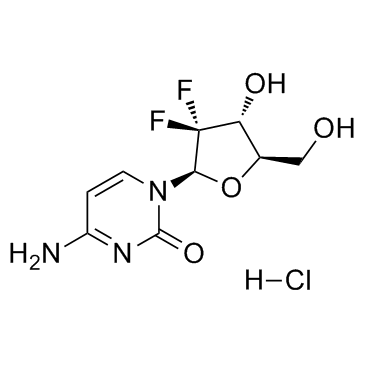Gemcitabine HCl

Gemcitabine HCl structure
|
Common Name | Gemcitabine HCl | ||
|---|---|---|---|---|
| CAS Number | 122111-03-9 | Molecular Weight | 299.659 | |
| Density | N/A | Boiling Point | 482.7ºC at 760 mmHg | |
| Molecular Formula | C9H12ClF2N3O4 | Melting Point | >250°C dec. | |
| MSDS | Chinese USA | Flash Point | N/A | |
| Symbol |

GHS08 |
Signal Word | Danger | |
|
Quantitative proteomics of the yeast Hsp70/Hsp90 interactomes during DNA damage reveal chaperone-dependent regulation of ribonucleotide reductase.
J. Proteomics 112 , 285-300, (2015) The highly conserved molecular chaperones Hsp90 and Hsp70 are indispensible for folding and maturation of a significant fraction of the proteome, including many proteins involved in signal transduction and stress response. To examine the dynamics of chaperone... |
|
|
Co-delivery of paclitaxel and gemcitabine via CD44-targeting nanocarriers as a prodrug with synergistic antitumor activity against human biliary cancer.
Biomaterials 53 , 763-74, (2015) Multi-drug delivery focuses on different signaling pathways in cancer cells that have synergistic anti-proliferative effects. In this study, we developed multi-prodrug nanocarriers (MPDNCs) consisting of poly (l-lysine)-carboxylate PTX (PLL-PTX) and hyaluroni... |
|
|
Systemic delivery of microencapsulated 3-bromopyruvate for the therapy of pancreatic cancer.
Clin. Cancer Res. 20(24) , 6406-17, (2014) This study characterized the therapeutic efficacy of a systemically administered formulation of 3-bromopyruvate (3-BrPA), microencapsulated in a complex with β-cyclodextrin (β-CD), using an orthotopic xenograft mouse model of pancreatic ductal adenocarcinoma ... |
|
|
Aneuploidy induces profound changes in gene expression, proliferation and tumorigenicity of human pluripotent stem cells.
Nat. Commun. 5 , 4825, (2014) Human pluripotent stem cells (hPSCs) tend to acquire genomic aberrations in culture, the most common of which is trisomy of chromosome 12. Here we dissect the cellular and molecular implications of this trisomy in hPSCs. Global gene expression analyses reveal... |
|
|
Synergistic activity of combination therapy with PEGylated pemetrexed and gemcitabine for an effective cancer treatment.
Eur. J. Pharm. Biopharm. 94 , 83-93, (2015) Combination therapy in cancer is now opted as a potential therapeutic strategy for cancer treatment. However, effective delivery of drugs in combination at the tumor site is marred by low bioavailability and systemic toxicity of individual drugs. Polymer ther... |
|
|
Gemcitabine treatment of rat soft tissue sarcoma with phosphatidyldiglycerol-based thermosensitive liposomes.
Pharm. Res. 31(9) , 2276-86, (2014) The pyrimidine analogue gemcitabine (dFdC) is frequently used in the treatment of patients with solid tumors. However, after i.v. application dFdC is rapidly inactivated by metabolization. Here, the potential of thermosensitive liposomes based on 1,2-dipalmit... |
|
|
Preparation of intravenous injection nanoformulation of VESylated gemcitabine by co-assembly with TPGS and its anti-tumor activity in pancreatic tumor-bearing mice.
Int. J. Pharm. 495 , 792-7, (2015) Our recent publication showed that VES-dFdC nanocapsules in pure water could be obtained via the self-assembling of VES-dFdC prodrug synthesized by coupling gemcitabine (dFdC) with vitamin E succinate (VES). To prepare the intravenous injection nanoformulatio... |
|
|
Mechanisms underlying the cytotoxicity of a novel quinazolinedione-based redox modulator, QD232, in pancreatic cancer cells.
Br. J. Pharmacol. 172(1) , 50-63, (2014) Pancreatic cancer is characterized by alterations in several key signalling proteins, including increased expression and activity of the Src tyrosine kinase and focal adhesion kinase (FAK), which have been linked to its chemoresistance. Sustained Src inhibiti... |
|
|
Gemcitabine diphosphate choline is a major metabolite linked to the Kennedy pathway in pancreatic cancer models in vivo.
Br. J. Cancer 111(2) , 318-25, (2014) The modest benefits of gemcitabine (dFdC) therapy in patients with pancreatic ductal adenocarcinoma (PDAC) are well documented, with drug delivery and metabolic lability cited as important contributing factors. We have used a mouse model of PDAC: KRAS(G12D); ... |
|
|
Repurposing of clinically developed drugs for treatment of Middle East respiratory syndrome coronavirus infection.
Antimicrob. Agents Chemother. 58(8) , 4885-93, (2014) Outbreaks of emerging infections present health professionals with the unique challenge of trying to select appropriate pharmacologic treatments in the clinic with little time available for drug testing and development. Typically, clinicians are left with gen... |